Wood burning boiler for the apartment. The use of a wood burning boiler. Wood boilers - installation requirements.
The rise in price of gas, diesel fuel and electricity is forcing residents of country houses to look for alternative sources of heating at home. Pellets, peat, woodworking industry waste, firewood - all this serves as an excellent fuel for wood-burning boilers.
1 And we heat everything with firewood - the last century or cost savings?
It would seem that the 21st century is in the yard, and here they tell you that it is better to heat with firewood. Of course, this is not about furnace heating- it's really last century. Modern wood-fired units - as professionals call them - have not only an attractive appearance, but also a high efficiency - from 70% to 90%! They are produced in almost every country where there is winter, they are imported and exported as a hot commodity and they come up with new models. The advantages of such boilers make you wonder if it is really worth heating the house with gas:
- 1.5–2.5 times savings on fuel bills compared to gas;
- to install a wood-burning boiler, you do not need to coordinate anything with the fire inspectorate, the local gas service or neighbors;
- a wood-fired boiler in most cases is able to work equally well on both wood and pellets, sawdust and even coal;
- wood-burning units can work offline, regardless of the connection to electricity;
- when connecting automation, you can optimize fuel consumption and minimize the frequency of loading new portions of fuel;
- many boilers can be equipped with cooking surfaces on which pet food can be cooked;
- With the help of wood-burning units, you can provide the house not only with heat, but also with hot water.
Of course, solid fuel boilers also have disadvantages. Simpler units now and then require a constant load of fuel, at least once every 2-4 hours. Yes, and the fuel needs to be stored somewhere - for this, sheds, woodpile are equipped. Raw wood reduces the boiler power by almost half, so the fuel must be well dried. Manufacturers are more than successful in solving these problems, however, high-tech boilers that need to be loaded every two days, with automatic temperature control or automatic fuel supply, are very expensive. It's time to figure out which wood-burning boiler should be purchased for the home.
2 Are they cheap, do they heat badly?
We will start our review with do-it-yourself boilers and inexpensive units from domestic manufacturers. In the first case, the owner of the boiler saves on the cost of the finished product by purchasing only sheet metal and pipes, but the manufacture of the unit will require a lot of skills and a lot of time. It cannot be said that a do-it-yourself wood-burning heating boiler will not do its job well - the efficiency of successful units reaches 70-80%.
The easiest way is to make a boiler of standard design, with lower combustion. An ash pan, a combustion chamber, a water register or a water jacket, a draft regulator, a chimney - that's the whole structure. More complex units can be equipped with shaft combustion chambers for a large amount of fuel, smoke swirlers, and numerous valves. With your own hands, you can even make a boiler with an upper type of combustion.

The disadvantage of such units is that the fuel burns out quickly enough, giving off heat to the system - during the combustion of firewood in the house it will be too hot, and after a few hours it will become cool again. Craftsmen, who are not averse to working with their own hands, solve this problem with the help of the so-called heat accumulator - a container of water that accumulates reserves of heated water and evenly releases heat into the system, providing the house with heat for a long time even after the firewood is completely burnt out. The more powerful the boiler, the larger such a battery should be - it is not uncommon for a capacity of 2-3 tons of water.
Not everyone can cope with the grinder, welding machine and sheet steel - most prefer to buy ready-made options. The cheapest in the market of heating appliances are steel heating boilers of domestic production. Again, some craftsmen make units for sale with their own hands, but it is better to purchase a boiler from a manufacturer who has high power and modern equipment. Factory welding in order better than that what a person can do in his garage, and the details are adjusted an order of magnitude more precisely. Plus powder coating, designed for high temperatures significantly extend the life of the boiler.
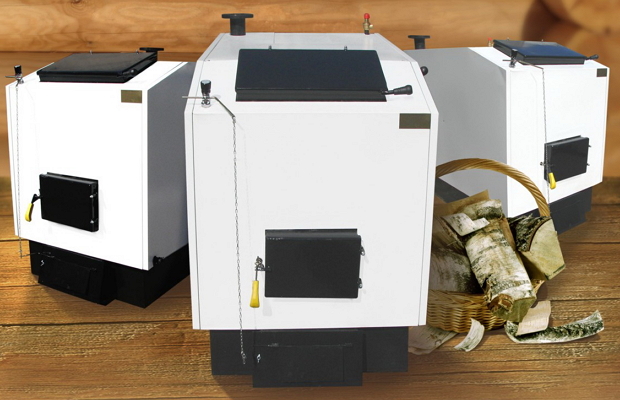
The cheapest units cost about $200–250. Basically, these are boilers of the simplest design, made of sheet steel. Nevertheless, the power does not depend on the price - you can buy a fairly powerful boiler for that kind of money. Another question is that it is unlikely to be economical and unlikely to last long - do-it-yourself units or purchased from domestic manufacturers rarely last longer than 10 years. On average, 5 years is already a good result for such boilers. But if you are in country house infrequently, it is qualitatively insulated and the source of fuel (a forest, for example) is nearby, then a wood-burning boiler from a low price category. The main thing is that the thickness of the steel should not be less than 4 mm.
3 Average price category - looking for the best ratio of quality and price
In the middle price category, boilers of domestic manufacturers who have managed to prove themselves, and imported units from Poland, the Czech Republic, Lithuania, Slovakia, and Germany are constantly fighting for the right to be purchased. For $500-800 you can buy an economical boiler with high efficiency - up to 90%. For this price, you can even buy a cast-iron boiler - this material is much more durable than steel. The body of cast iron boilers consists of separate monolithic sections, which greatly simplifies the process of assembling the unit with your own hands. Repair is carried out by replacing the section with a new one. Cast iron is resistant to both dry and wet corrosion, therefore, under all conditions, it can last several decades.

The main trouble with cast iron is its brittleness, it cannot withstand sudden changes in temperature and can suffer from mechanical damage. Even cold firewood should not be loaded into a heated boiler.
Steel serves much better - it is not afraid of either mechanical damage or sudden changes in temperature. Corrosion resistance today is achieved by adding special compounds to the coolant that stop the oxidation reactions. The main disadvantage of boilers is the burnout of steel, so you should choose units only from heat-resistant metal.

When choosing a heating boiler, most people use the standard boiler power calculation scheme - per 10 sq. m area you need 1 kW of boiler power. However, we do not recommend purchasing units whose power is close to the heated area. The fact is that this calculation is rather averaged - these data are relevant for a heated, insulated house, in which you only need to maintain a given temperature. Much more thermal energy is needed to warm up a cold house. Therefore, take a boiler with a margin of 25-30% of power, you will not lose. And the unit will last much longer, because it will rarely have to work at full capacity - only when for some reason you have not heated the living quarters for a long time.
4 Long burning is a homeowner's dream
And yet today the most desirable are the boilers long burning, which can work on one load of firewood up to 40 hours, and on coal - all 5 days. The undoubted leader is the company "Stropuva" (Lithuania). Boilers under this brand are completely different from units from other companies - they have a very convenient elongated shape and take up very little space in the room. Such units cost from $ 1000 or more, depending on the power of the product.
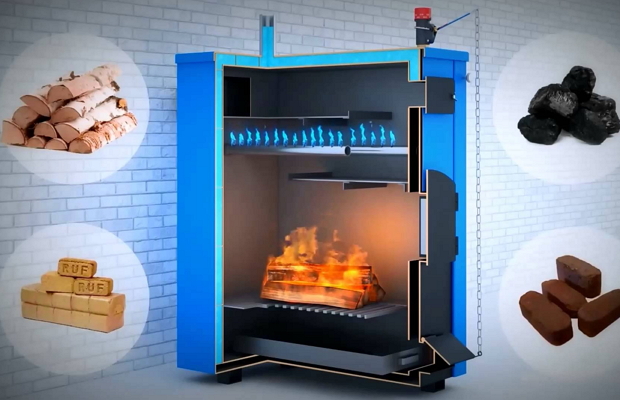
- perhaps the most expensive type of heating units. Inside these boilers, a gas generation process takes place - pyrolysis gas is released from the wood, which burns in a separate chamber, and only then does it burn out solid fuel. Thanks to this, the boiler consumes one and a half times less fuel to produce the same amount of heat than a traditional boiler. On one load of firewood, pyrolysis boilers can work up to 12 hours. It is important that the firewood is very dry.
Content
- Firewood as a type of fuel
- Advantages and disadvantages of wood heating
From time immemorial, people have used firewood to heat their homes. With the advent of alternative fuels such as gas, diesel and electricity, they began to fade into the background, but are still one of the main types of fuel in our country. In this article, we will consider a wood-fired heating boiler, the advantages and disadvantages of using firewood as a type of fuel, as well as the installation features of heating devices of this type.
Before moving on to the consideration of wood-fired boilers with a water circuit, let's first take a closer look at this type of fuel. What is the secret of their special popularity in Russia and what are the disadvantages of using them in the heating system of your private house or cottage.
The top leaders have already emerged on the Russian market, among the models working on pellets. It is to them that this review is dedicated. So let's get started.
Firewood as a type of fuel
As you know, firewood is a part of a tree trunk intended for burning in order to obtain heat and light. This type of fuel is widely used in our country not by chance, because. most of it is covered with forests of various species.
Photo 1: Pine wood for a solid fuel boiler
Coniferous and hardwood firewood have different calorific value. The former give less heat and burn out much faster. In addition, they take up more space due to their low density. Hardwoods, on the other hand, burn hot and for a long time. That is why, the owners of country houses, if possible, try to harvest hardwood firewood.
Unlike oil and gas, firewood is a renewable source of energy. This is their feature, among others, and brought them such popularity. One cubic meter of wood in terms of calorific value is equal to 200 liters of oil and 200 cubic meters of gas. Another significant advantage is their low ash content in the region of 1-2%.
The disadvantages of firewood include their low calorific value compared to the same gas or coal. Another disadvantage is high humidity. The process of water evaporation steals some of the useful heat, while reducing the overall calorific value.
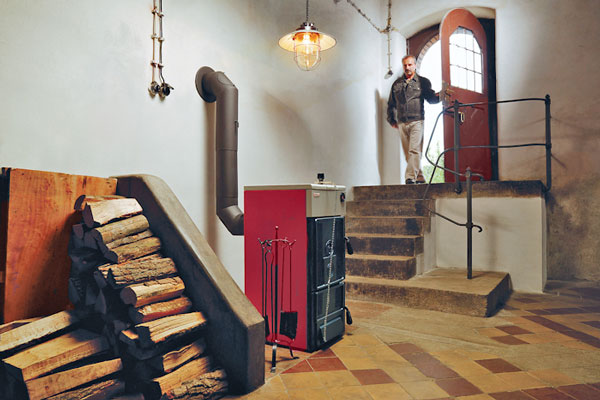 Photo 2: Installing a hot water boiler in a boiler room country house
Photo 2: Installing a hot water boiler in a boiler room country house
Harvesting firewood for the entire heating season is not an easy task. A forest of a suitable species is felled, knots are cut off and then the tree trunk is sawn into short pieces called "chocks". Subsequently, the chocks are stabbed with a special ax called a “cleaver” into individual logs, which are then stacked in woodpile in a specially equipped place under a canopy.
In cold winters, firewood is used to heat stoves in the house and bathhouse, and is also used in central heating boilers. Let's look at what it is, what its device and design features are.
Back to indexWater heating boiler device
Water-heating boilers are cast-iron or steel devices, by burning solid fuel in which the coolant is heated in a special tank, which in turn circulates through a closed heating system and heats the room.
 Photo 3: The principle of operation of a wood-fired boiler with a water circuit
Photo 3: The principle of operation of a wood-fired boiler with a water circuit Wood-fired boilers are the simplest and cheapest devices that can only be bought from solid fuel heat generators. Structurally, they consist of the following units and assemblies:
loading chamber
The loading chamber or firebox, as it is also called, is a compartment with a door in which the firewood is placed. A feature of a wood-fired boiler, unlike coal or pellet boilers, is the presence of a larger firebox that allows you to accommodate fairly large logs.
Ash pan
The ashpit (blower) is located in the lower part of the heating boiler, directly under the furnace, and serves to collect the combustion products of solid fuel in the form of ash. To ensure cleaning, the blower is equipped with a door.
grate
The grate is a grate made of steel or cast iron that separates the firebox and the ash pan. Through the holes in the grate, the ash formed as a result of combustion is poured into the ash pan. Also, through these holes, air is supplied to the combustion chamber, improving traction and fueling combustion.
heat exchanger
Structurally, a heat exchanger is a container of complex shape, inside of which there is a coolant, most often water. The complexity of its shape is due to the fact that to ensure maximum heat removal inside the boiler. The variety of its designs is quite large. Each manufacturer tries to bring his own innovation that can increase the efficiency of the boiler. The most common type of heat exchanger is the water jacket.
Chimney
In the process of burning wood in a heating device, volatile products are released, which must be discharged into the atmosphere. For these purposes, the chimney in a solid fuel boiler serves. Having given maximum energy to the coolant, volatile gases rush along chimney out. Correct is extremely important, because. The combustion products of firewood contain toxic compounds and their entry into a dwelling can lead to sad consequences.
As you can see, the heater is simple. Additionally, in modern TT boilers, various additional devices are used to increase the efficiency of their work, such as: draft regulators, smoke exhausters, etc. There are also both single-circuit and double-circuit modifications, with the possibility of hot water supply.
 Photo 4: Boiler chamber for loading firewood
Photo 4: Boiler chamber for loading firewood The principle of operation of water heating boilers is as follows. The boiler is installed indoors, filled with coolant and connected to the supply and return lines heating system. A portion of firewood is loaded into the firebox and set on fire. Burning, firewood heats the coolant, which moves through pipes to radiators in various parts of the house. Having given heat to the premises, it returns back to the boiler, where it is heated and the process is repeated. The ash accumulates in the ash pan, from where it is then removed during the cleaning of the boiler. Flue gases are discharged outside through the chimney.
Despite the active gasification in many regions and districts of the Russian Federation, they are still relevant for heating a private house. They are appropriate where there is no gas boiler or gas supply costs are too high. On the other hand, a wood-burning heating option is much better than a massive brick oven.
To decide whether you generally need this device in the house or not, get to know it better. Solving the issue of heating a house does not require fuss and hasty decisions. You need to understand all the nuances.
Device
- firewood is loaded into the furnace;
- through a heat exchanger made of steel or cast iron, heat is transferred to the coolant (the boiler is connected to a water circuit for heating the house). As a result, the entire room is heated;
- The principle on which the boiler is based wood heating, is pretty simple:
Manufacturers continually invent new solutions. Follow the latest market news, each modification has its own nuances.
- different wood-fired boilers differ primarily in the size of the combustion chamber - the larger it is, the higher the power of the unit.
heat exchanger
When choosing a heating furnace, the question often arises: which heat exchanger should be preferred?
Heat exchangers also differ from each other: 
- steel heats up quickly. But it also cools down faster, although it is important for a water circuit oven that the water heats up as soon as possible. Service life on average 10 years;
The main disadvantage of a steel heater is its vulnerability to corrosion. Therefore, a water circuit filled with distilled water is sometimes used, although this implies some expense.

- the cast-iron element heats up longer and gives off heat for a longer time. It has an impressive service life (will last at least 20 years).
With frequent and sharp temperature changes, the cast-iron heat exchanger is prone to fairly rapid destruction. Be careful when operating.
Varieties
The consumer has a choice among several solutions, each of which has its pros and cons. In any case, the heating systems of a residential building must be reliable, and also meet the requirements for thermal power (living area, intensity of operation, length of the cold season in the region, etc.).
Boiler classic
This design is the simplest and most understandable of all that exist on the market today.
Peculiarities:
- similar to an ordinary stove - equipped with a firebox, a chimney and an ash pan;
- operation does not require complex knowledge;
- runs on fuel with low efficiency;
- consumes a large number of firewood.
According to user reviews, such stoves are relatively effective in heating small rooms where there is no need to supply the boiler with a water circuit (that is, such devices are not suitable for heating a private house).
If installation of carrier wiring is planned at your facility, classic boilers will not suit you.
Pyrolysis boiler
 The efficiency of such heating is much higher than in the previous case.
The efficiency of such heating is much higher than in the previous case.
Design features:
- relative novelty on the market (therefore, reviews are still few and it is premature to draw global conclusions);
- it is possible to develop a high efficiency;
- with high efficiency, significant savings in fuel consumption are achieved;
- exhaust gases during the combustion process move into the pipe;
- from the pipe, pyrolysis gases transfer their temperature to the heat exchanger;
- Judging by the foregoing, I would like to call this design ideal. However, it has a significant drawback - a strict selection of fuel.
Long burning boilers
 According to experts, for heating a private house, it is preferable to
According to experts, for heating a private house, it is preferable to
Peculiarities:
- such boilers with a water circuit are able to work for long hours on one wood-burning bookmark (the figure of 3-5 days speaks for itself, and the good reviews of grateful users only enhance the reputation of these products);
- such long-burning furnaces can operate on different types fuel (and are easily rebuilt from one to another).
Alas, to buy one for little money is simply unrealistic. Comfortable pleasure costs a lot of money and, as they say, will cost a pretty penny.
Safety requirements
It should be remembered that boilers with a water circuit require attention from a safety point of view. This is not only about ignition risks, but also about full-fledged air-gas circulation.
Fire hazard.
- The most important are the following points:
- availability of free space for storing fuel - firewood cannot be stored directly at the stove, since the risk of ignition increases;
- it is necessary to provide exhaust ventilation indoors, especially if you purchased a boiler to heat your house high power;
Without sufficient ventilation, the unit will not cope with the amount of gases emitted during combustion. But among them there is carbon monoxide.
- it is strictly necessary to ensure the remoteness of the boiler from the walls and from the ceiling at a distance of at least 1 m;
- the size of the room must be at least 8 square meters. meters;
- the base must be non-flammable. For this purpose, the site is concreted. Another option is to cover the existing pedestal with tiles or iron, if it is, for example, wooden.
Chimney
The safety of the whole house and residents also depends on:
- flue material - stainless steel. Only this material will protect the structure from the deposition of greasy soot and resinous substances. Stainless steel has a high slip coefficient, that is, microparticles repel rather than “stick”;
Simple iron pipes are very difficult to clean due to the abundance of tar and soot deposits.
- make sure that the chimney passes through the wall of the house at a certain angle, and ideally, you need to make a hole in the roof. This measure will ensure the full release of combustion products to the outside;
- Be sure to place the upper edge of the pipe about 1 m above the roof ridge. Otherwise, there will not be sufficient traction.
Buy or DIY
 Is it possible to make a wood-fired boiler yourself? Of course, Russian craftsmen are capable of much. However, the end result will be significantly lower compared to purchased designs. And if it is more or less simple to build a stove for low-power heating of a house, then it is hardly possible to create a powerful long-burning unit.
Is it possible to make a wood-fired boiler yourself? Of course, Russian craftsmen are capable of much. However, the end result will be significantly lower compared to purchased designs. And if it is more or less simple to build a stove for low-power heating of a house, then it is hardly possible to create a powerful long-burning unit.
As a result, your costs will be significant (search for materials, time, worries, damage in case of an unsuccessful experiment), and you will not be able to get sufficient heating. It is advisable to spend money once on solid equipment, and enjoy everyday comfort for many years.
The most expensive are long-burning modifications, all the same, the costs pay off handsomely. The myth that prices are too high can be easily dispelled by starting to use a modern unit in practice.
Do-it-yourself home-made wood-burning boilers and stoves will not give the high power and high user safety that factory products are capable of.
Disadvantages and risks in the operation of homemade boilers:
- short service life;
- the inability to ensure long-term combustion;
- low efficiency;
- overheating of the case (hence - burns with accidental touches).
Almost all user reviews suggest that it is better to find several tens of thousands of rubles for a quality product than to try to build an engineering masterpiece and still not achieve the desired goal.
How much do wood-fired boilers and wood-burning stoves with water heating cost? Focus on the order of prices in the region of 58-65 thousand rubles. at a power of 20-24 kW. The most positive reviews are addressed to such models as Protherm DLO 30, Dakon DOR F 24, Buderus Logano G221 and a number of others. Note that prices are always slightly higher.
Heating a private house with a solid fuel boiler is a profitable solution, because it is a fairly economical unit with high efficiency. Therefore, you can safely buy it in the store and even make the installation yourself.
Varieties of modern wood-fired heaters
The process of heating on wood can occur with the help of such devices:
Advantages and disadvantages of equipment
Such wood-burning stoves have a number of advantages over other appliances for heating a private house:
- high efficiency - from 80% to 93%;
- the economy of this type of heating, since the cost of firewood is much lower than gas or electrics;
- you can use not only firewood, but also waste from the wood industry - shavings, sawdust;
- gradual heating of the room;
- when installing the unit, it is not necessary to additionally equip the foundation;
- it is possible to connect to the water heating system of a private house;
- environmental friendliness of the device;
- unit safety;
- does not need professional maintenance.
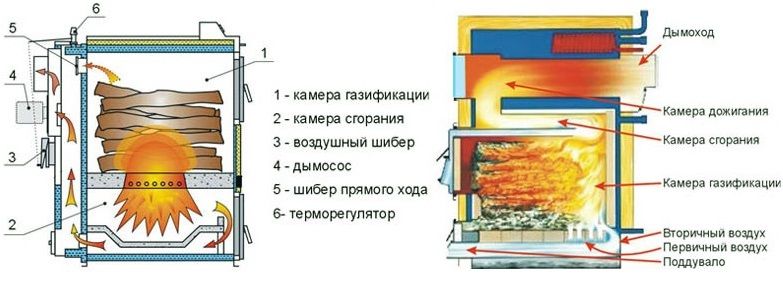
In addition to significant advantages, the process of heating on the wood of a private house can cause some difficulties, especially if it is not possible to constantly be near the device. As the firewood burns, you need to throw in new logs. This system requires constant cleaning, because the walls of the device and inner surface the chimney accumulates a lot of soot.
It is also important to provide a place to store a large amount of firewood, which must be dry.
Heat exchanger for wood burning boiler
If a solid fuel heater is equipped with a heat exchanger in the form of a water jacket, a horizontal or vertical pipeline, the efficiency of the system increases by 10-15%. Not only water, but also other liquids with sufficient heat capacity can act as a heat carrier.
The boiler with a water jacket is a firebox, which is placed in a barrel. If horizontal piping is used, the hot water pipe or supply must be elevated above the cold pipe or return.
When placed vertically, the heat exchanger can be either strictly vertical or at a slight slope. It is best to place pipelines in a checkerboard pattern to increase the productivity of the heating system at home.
For the manufacture of modern registers for the heat exchanger, heat-resistant steel is used, which has a high thermal conductivity.
We make a boiler from an old gas cylinder
A do-it-yourself wood-burning boiler can be made using an old unnecessary gas cylinder.
Also for this device you will need:
- metal corners;
- a small metal grill;
- cast iron door;
- Metal sheet;
- chimney pipes.
Step-by-step instructions for heating a country house:
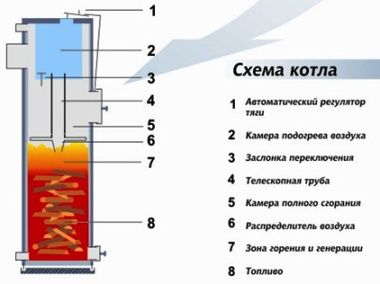
Many owners of suburban areas do not have the opportunity to use natural gas, so they have to use wood-burning boilers for summer cottages. Such modern devices are characterized by an increased duration of operation and a high efficiency. When purchasing wood-burning boilers for home heating, it is worth knowing about the features of their installation. It is best to hire a professional, as without experience in carrying out work, serious mistakes can be made. In some cases, a heater is purchased for a greenhouse.
Principle of operation
Heating boilers that work by using wood are very different from traditional wood stoves. In their structure, they resemble a thermal station. But it is worth noting that the basic principle of operation remains unchanged.
The difference from wood stoves is the presence of a water circuit. The described devices allow you to connect a radiator heating system with a chamber in which firewood is burned. They are divided into two types:
- Pyrolysis. Their difference lies in the fact that they simultaneously use the heat obtained by burning wood and afterburning the resulting gas. It is worth noting that long-burning boilers are very similar in principle to pyrolysis boilers. The described devices differ in that one bookmark of firewood is enough for a long-term operation of the boiler.
- classic boilers. They are devices that work on the same principle as traditional ovens. Such equipment has a low cost, therefore, it is purchased by many owners of private houses.
The solid fuel boiler is a modified wood-burning stove with automation of the combustion process. When purchasing a wood-burning boiler, you should not choose expensive models for the garage that are designed for heating large rooms.
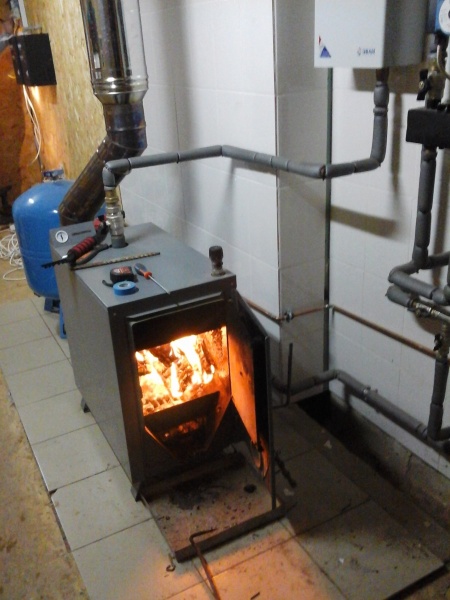
How to choose a device
When purchasing a wood-fired boiler, there are several points to consider:
- The area to be heated by the boiler.
- Type of heating boiler. As mentioned earlier, there are several types of such devices. Pyrolysis devices are the most economical. But it's worth noting. That they have a higher value.
- Type of boiler heat exchanger. They differ in the type of materials used and in design features. Steel products have a lower cost and are not afraid of mechanical damage. It is also worth noting that they are easy to repair and maintain. Buying a cast iron boiler wooden house, it is important to remember that it can be used for 35 years and is afraid of mechanical damage. It is also worth noting that such devices are heavy.
- Camera features. Many manufacturers produce boilers with the ability to side-load firewood. It is also worth paying attention to products with loading from above. A similar design is used in gas generating devices. The main advantage is the ability to dry firewood.
- Additional functions. Many boilers are distinguished by the presence of automation. Also, some devices have a built-in boiler and the ability to remote control. Greenhouse boilers are usually simpler devices.
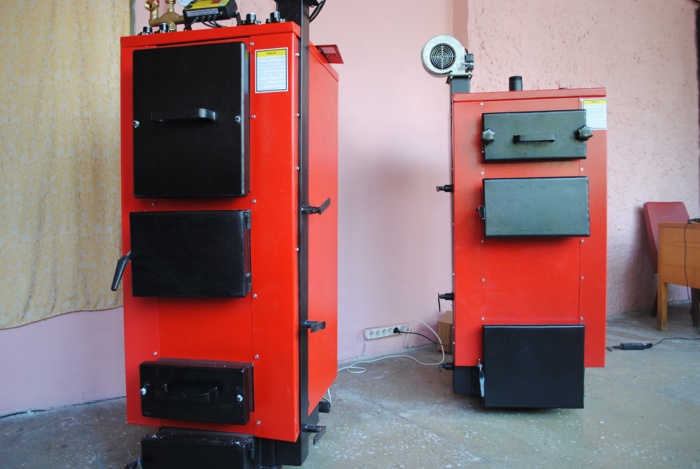
In addition, you need to decide on the brand of the purchased device. To do this, you should learn more about well-known manufacturers of such equipment for the home. Often, the owners of the plots purchase wood-burning boilers for the bath.
Wood boiler cost
The cost of the described products is influenced by several factors. These include:
- Heat exchanger type. Cast iron products are more expensive.
- Manufacturer. Some manufacturers' products are more expensive. Often the price reflects the quality of the products.
- The principle of operation of boilers. For example, the cost of a wood-burning gas generating device is approximately 35 thousand rubles. Classic heating boilers have a price of about 20 thousand rubles.
- Availability of additional equipment.

It should be noted that if the device is registered with Rostekhnadzor, no documents for commissioning are processed. Often the product is purchased for the greenhouse. These devices are easy to install.
Boiler installation
Wood burning boilers are connected to the existing radiator system. During such work, it is necessary to comply with building codes and regulations. It is also important to follow fire safety rules.
It is important to properly equip the storage for firewood so that they can be conveniently obtained if necessary. During the season, the device usually burns about 15 cubic meters of firewood. The boiler is installed in the basement or on the street.
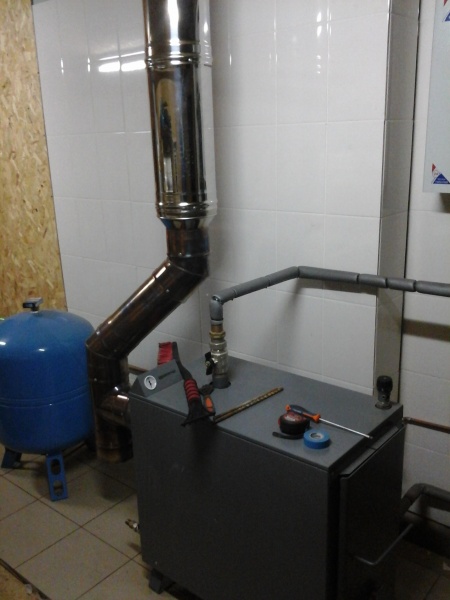
Where should the device be installed
Installation of the described device can be carried out anywhere in the house, but it should be remembered that it must comply with fire safety requirements.
Please read the following instructions carefully before installation:
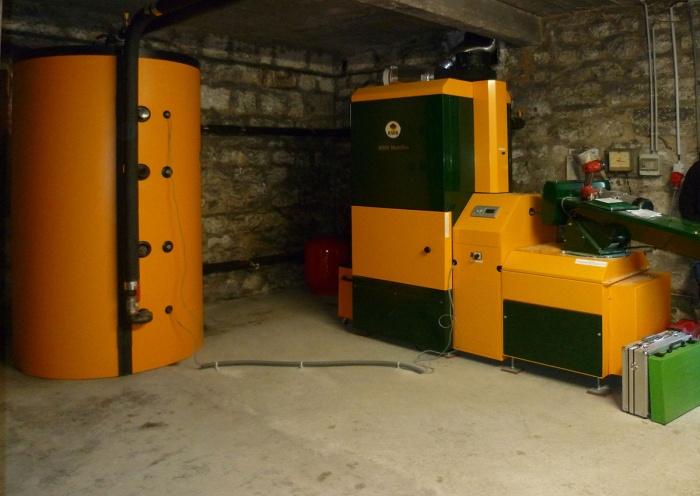
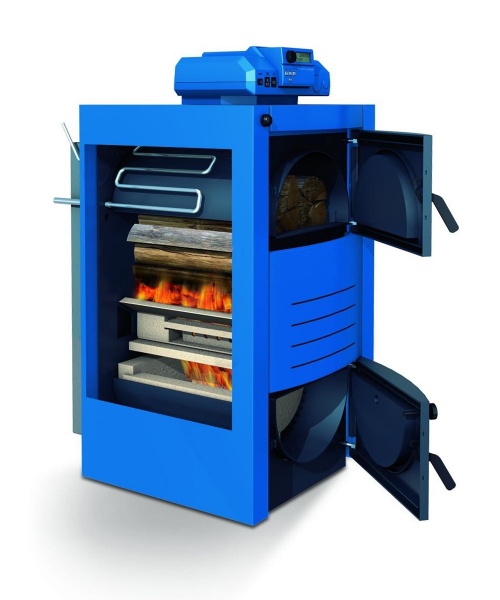
It is worth remembering that connecting a modern boiler requires an electrical network. When using such a device, a voltage stabilizer should be used. Automation is usually connected directly from the switchboard. When installing a chimney, fire safety rules must be observed.
All heating elements of the described device must be isolated. A spark arrester must be installed on the pipe head to eliminate the possibility of a fire.
The main requirement when using the boiler is to comply with the basics of fire safety. During operation, it is necessary to ensure that there is no smoke in the room or boiling of the coolant. Often the device is purchased for installation in a greenhouse or garage.
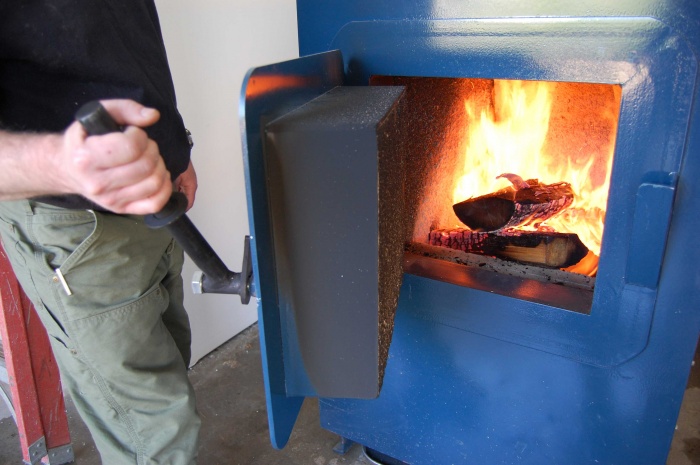
Heating schemes
There may be several heating schemes for a private house in which a wood-burning heater is installed. They differ from each other in the following ways:
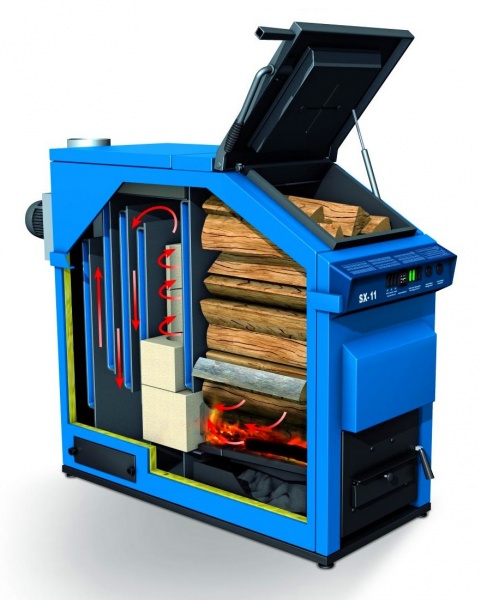
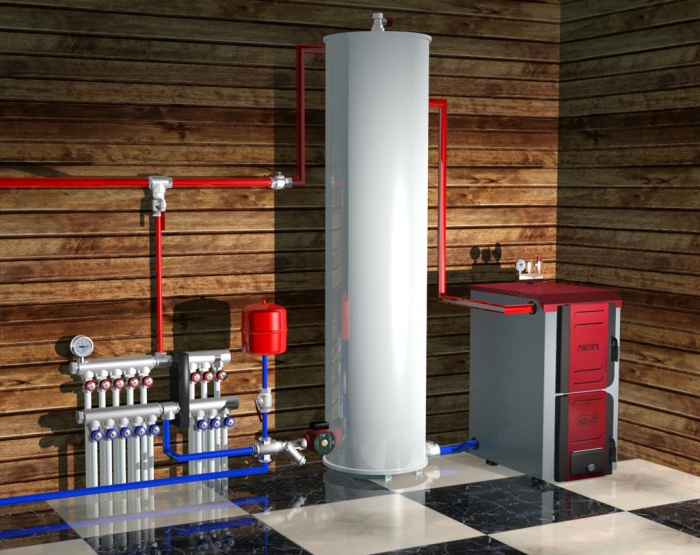
Before creating a liquid heating system, it is necessary to carefully develop a scheme, and during operation, observe building codes. It should be noted that when installing circulation pumps, it is necessary to connect a voltage stabilizer and a UPS. The described devices are highly efficient and can replace gas equipment.



